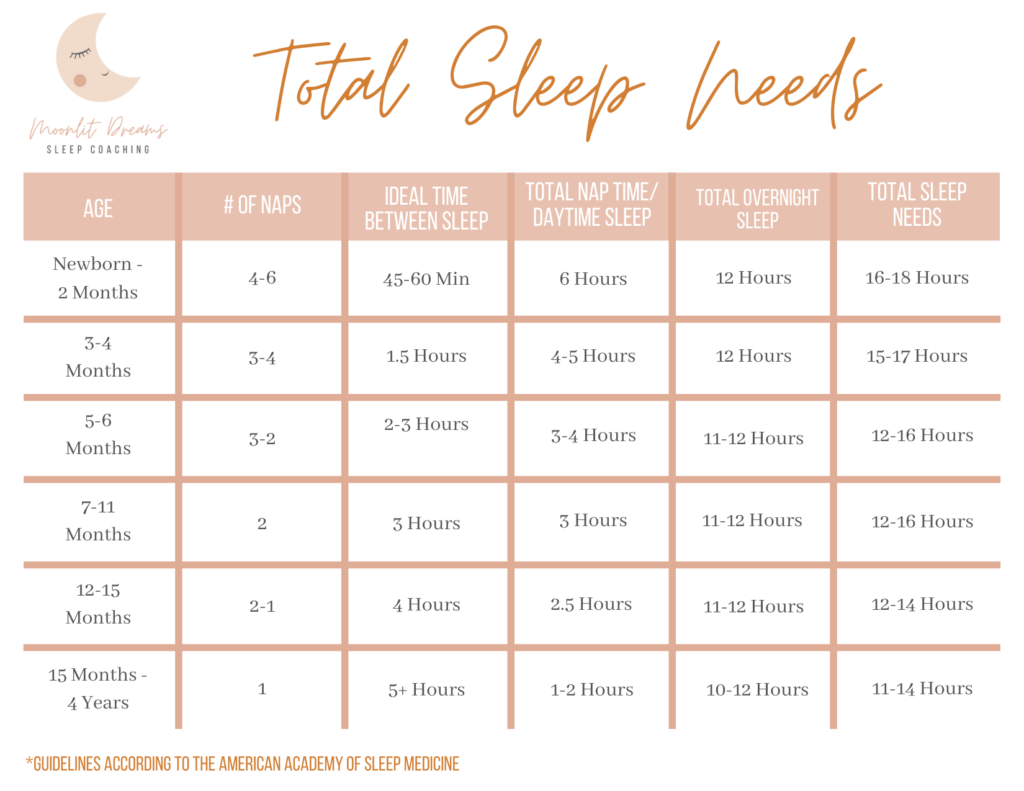The dreaded short nap, or worse, the nap protest. It happens to the best of us, and it’s the worst! In this blog, I am going to give you 5 tips to help get your child’s naps back on track!
- Understanding Your Child’s Total Sleep Needs and Awake Windows By Age
- Timing of Their Naps
- Understanding Stages & Cycles of Sleep
- Supported and Unsupported Naps
- Nap Routine & Training
- BONUS TIP: What if we have an off day?
Understanding Your Child’s Total Sleep Needs and Awake Windows By Age
Depending on the age of your child, they need a certain number of hours of sleep in a 24 hour period. Their daytime sleep needs also line up perfectly with their proper awake windows. For example, a 7 month old needs between 12-16 hours of total sleep, to take 2 naps a day, and should not be awake longer than 3 hours between naps. This means that in the 12 hours of daytime, let’s say between 7am-7pm, they are taking two naps that are totaling 3 hours, plus their overnight sleep of 12 hours from 7pm-7am, so they are getting a total of 15 hours of sleep in a 24 hour period. This is an appropriate amount of total sleep, naps, and awake windows for a 7-12 month old. I have included my Total Sleep Needs chart below, as well as a downloadable link here, so you can find where your child falls.

Timing of the Naps
Ensuring you are putting your child down for a nap at the right time is going to be super important for a successful nap. If you’re putting your child down for a nap and all they’re doing is playing, kicking, rolling, and not settling, you’ve likely put them down too early and they are just not ready for sleep! If you find that this is happening, I suggest pushing out their awake window by 15-30 minutes to help them settle quicker and easier.
If your child is going down too late, then you’ve likely surpassed their proper awake window and this often results in protest, outbursts, and lots of tears. When a child is overtired, they lose the ability to self-soothe because they now have stimulant hormones (adrenaline and cortisol) flooding their little body; forcing them to stay awake. Paying attention to those awake windows, and putting your little one down 5-10 minutes BEFORE they should be asleep, is going to be ideal so that they have time to settle before falling asleep, which will avoid them becoming overtired while trying to settle.
Understanding Stages and Cycles of Sleep
If you have a child who is between the ages of 0-12 weeks, they are going to be sleeping in stages of sleep meaning 50% in REM and 50% in Non-REM. Stages change to cycles around 12 weeks, so your child will be waking more often as they go through their cycles of sleep. This is why a lot of parents will see the 4 month sleep regression happen around now, especially if their child has never learned to fall asleep independently and relies on a crutch or prop like feeding, rocking, driving, moving to sleep. Pacifiers can be a big culprit as well. (See my blog post on knowing how and when to drop the pacifier here!) If you’re finding that your child is taking short naps that are only lasting 45 minutes, it could be one of two things. One being, their age; children do not possess the ability to consolidate their naps and connect their sleep cycles until they are between 4-6 months of age. The second reason being, that they are relying on support to sleep; such as one of the props listed above. With that being said, fixing the overnights FIRST, and teaching your child to be an independent sleeper, is going to be your best bet before you try to fix their naps.
Supported vs. Unsupported Naps
Now, I am not saying that supported naps are completely taboo. They can be SUPER helpful in those early months between 0-5 months of age before they have the ability to consolidate naps. A supported nap can mean, in their car seat on a drive, on a walk in their stroller, or a crowd favorite; contact nap. These are all movement based support, and typically the ways you find your baby sleeps the longest! An unsupported nap would be laying your baby down awake in their crib or bassinet, and allowing them to fall asleep independently. Finding a balance between the two is going to be extremely beneficial for a number of reasons. First, having assisted naps thrown in will ensure that your baby is getting the proper amount of daytime sleep that they need, and avoid being overtired going into their next nap or bedtime. Second, balancing in a few unsupported naps gives your baby practice with falling asleep independently and helps to get them used to their permanent sleep space. A good rule of thumb is to have 80% unassisted naps and 20% assisted naps, so that by the age of 6 months, you can move to 100% unassisted naps with ease and avoid forming a habit with the assisted naps.
Helpful Tip: While you are still balancing between assisted and unassisted naps, try that first nap of the day in their crib or bassinet. Lie them down awake, and allow them to settle on their own. The reason I suggest the first nap is because they are coming off their full night sleep well rested and not overtired, and their first nap of the day is usually the most predictable and consistent since they are typically waking up at the same time everyday.
Nap Routine & Training
Kids thrive on consistency, so establishing a nap routine can be very beneficial when starting to nap train your child. Have it be similar to their bedtime routin. For example; start by changing them, draw the curtains, dim the lights, turn on the sound machine, read a book, and get a few snuggles in. Then, ensure that their room is as dark as possible, lay them down in their safe sleep space either in a swaddle, sleepsack, (depending on their age) or with a blanket/lovie (if you have a toddler). Do this every time before a nap, and it will start to indicate to them that sleep is coming.
Helpful Tip: Having black out shades, curtains, or window-cling can be super helpful to create complete darkness in your child’s room, which is going to be optimal for sleep and extending those middle of the day naps.
The reason naps take longer to grasp is because they are only happening a few times a day, so your child is only practicing connecting their sleep cycles as many times as they’re napping. Consistency, practice, and patience are KEY when it comes to nap training. Keep the routine, break the habits, and practice, practice, practice! Don’t forget to give yourself grace, and remember it takes time! Sleep is a skill set, and the more your child practices, with good habits, the better they will get, and the more everyone will sleep!
BONUS TIP: What if you have an off day
What if your child misses a nap or has a short crap nap due to teething, traveling, or some other unforeseen circumstance? First, breathe, and remember that life happens. Second, adjust the bedtime by at least 30-60 minutes depending on what time they typically go to bed. The last thing you want is for your child to get super strung out and overtired going into bedtime, because that can result in the inability to settle, overnight wakings, and early morning wakings – EW. Let’s say your little one is on one nap a day, and they typically sleep from 12:30-3:00pm, then go to bed at 7:30pm. But today, they woke up at 2:00pm, due to teething, and would not settle back down; what do you do? You go about the rest of your day normally, but instead you shorten that last awake window and put them down for bed between 6:30 and 7:00pm. This ensures they are not getting overtired when going down for the night. Then tomorrow, you start fresh, and continuing being the boss b*tch you know you are!
Still struggling with naps? Check out my Naps Master Class here!
Need Additional Support?
Let's connect to discuss your child's sleep struggles, and how I might be able to help.

